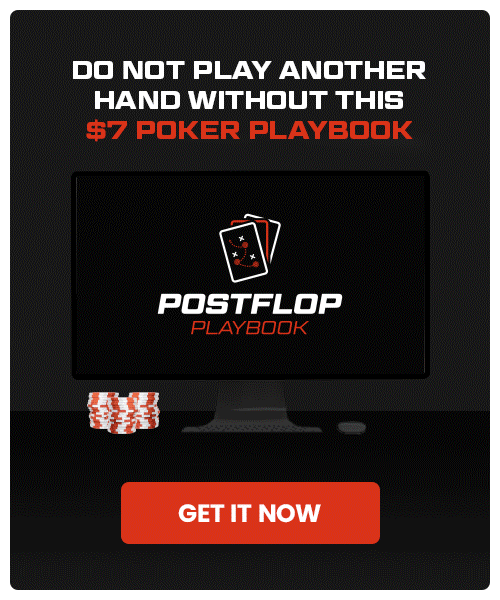What Is Effective Stack Size & Why Does It Matter?
One of the first factors you should consider in any given poker hand is the effective stack size.
This article lays out what “effective stack size” means and why it’s important.
Let’s dive in.
What is Effective Stack Size in Poker?
Effective stack refers to the effective amount of chips that are in play in a hand. For example, if you have a stack of $2,000 and your opponent has a stack of $550, the effective stack is $550. Though you have more chips than that, the maximum you can play for in the hand is your opponent’s $550.
Let’s go through one more example. Suppose you are at a 4-handed table and you have 100 big blinds (bb) in your stack, while the other players have the following:
- Player 1: 30bb
- Player 2: 100bb
- Player 3: 130bb
Then your effective stack size will differ depending on which player you are up against.
Therefore, if you have 100bb in your stack:
- Against Player 1, you have an effective stack size of 30bb
- When battling Player 2, the effective stack size is 100bb
- Against Player 3, the effective stack size is 100bb (because you have a smaller stack)
Note: Want to get better at poker without spending a lot of time or money? Get the $7 crash course that will help you win more often. Grab your Postflop Playbook now!
Why Does the Effective Stack Size Matter?
The effective stack size has significant implications for both in the preflop and postflop strategy.
Effective Stack Size and Preflop Strategy Implications
Let’s first cover how this concept affects preflop strategy.
Keeping the effective stack size in mind is critical in all game types, but it’s especially important in tournaments because of the stack sizes and blinds are constantly changing.
To demonstrate how much the effective stack size impacts optimal preflop strategy, let’s take a look at a few preflop charts from the Road to Victory tournament course (taught by elite pros Darren Elias and Nick Petrangelo).
Example: the Button raises, the Small Blind folds, and you are in the Big Blind.
Here’s what I want you to focus on while reviewing these charts: the frequency of the defense remains quite stable (~60% calling and ~15% 3-betting), but the hand selection and 3-bet sizing changes dramatically.
15bb Defense Range vs Button Open:
Note that the player on the Button uses the minimum 2bb open size at 15bb
30bb Defense Range vs Button Open:
Note that the player on the Button uses a 2.2bb raise size at 100bb
100bb Defense Range vs Button Open:
Note that the player on the Button uses a 2.5bb raise size at 100bb
Why does the effective stack size affect the preflop ranges so much?
Well, it’s because of another 4 pieces of the poker puzzle:
- Equity (and realized equity)
- Fold Equity
- Minimum defense frequency (an advanced form rather than the basic equation)
- Pot odds
Let’s compare the 15bb effective stack defense strategy with the 100bb one. I’ll save your scroll finger by dropping them here side by side:
The most significant difference between these ranges has to do with 3-betting.
At 15bb, the Big Blind 3-bet shoves with 16.6% of hands and never 3-bets to a small size. At 100bb, the Big Blind only uses a non-all-in 3-bet size (no shoving).
Why is that?
The short answer is that 100bb is way too much to shove over a 2.5bb raise. In that case, you’d be risking your remaining 99bb to win the ~5bb in the pot. At 15bb stacks, on the other hand, risking your remaining 14bb to win the ~4.5bb in the middle is a reasonable proposition.
For the longer answer, read the nerdy poker stuff in the box below.
When we shove 15bb over the 2bb open-raise, the Button has a lot of factors to consider when deciding how to respond. He must consider what pot odds he’s getting, how much equity he has against your shoving range, and how often your 3-bet needs to work in for it to breakeven for your worst hands.
On the other hand, the Big Blind must consider a few factors when deciding what to do, including (in no particular order):
- How much fold equity he has (blocker effects taken into consideration)
- How much equity he will have against the calling range
- How the expected values (EV) compare between calling and raising
Using the power of solvers, we learned that building a non-all-in 3-betting strategy at 15bb effective stack is sub-optimal. You don’t capture any extra EV by 3-betting to a smaller size with some hands.
So, the end result is a shoving range made out of hands that are:
- Shoving for value (i.e. their equity when called is >50%)
- Hands that realize their equity best by shoving (i.e. these hands capture more EV as shoves compared to calling and trying to maneuver postflop)
Now, when looking at the 100bb effective stack strategy, we see that the all-in option is never used. This happens because the risk/reward equation is extremely disproportionate towards risk.
As a comparison, you need to shove 99bb to win 5bb, compared to shoving 14bb to win 4.5bb.
How many hands can profitably risk so much to win so little? Extremely few. And some of those hands that can profitably shove (such as AA and KK) benefit more from a smaller size.
Effective Stack Size and Postflop Strategy Implications
The postflop implications of effective stack size revolve around the concept of stack-to-pot ratio (SPR).
SPR quantifies the ratio between the size of a player’s remaining chip stack and the current size of the pot. It’s a useful metric that helps players make strategic decisions in no-limit and pot-limit games.
The SPR is calculated by dividing the effective stack size (the smaller of the two stacks in a given hand) by the pot size after the preflop betting round. Mathematically, it can be expressed as:
SPR = Effective Stack Size / Pot Size
The resulting SPR value provides insight into how much maneuverability a player has in postflop betting, given their stack size and the size of the pot. The higher the SPR, the more maneuverability you will have.
The SPR will be drastically impacted by how many bets went in before the flop.
- Single Raised Pots. When only one raise goes in preflop, the SPR will be relatively high.
- 3-Bet Pots. When there was a raise and a re-raise preflop, the SPR will be relatively middling.
- 4-Bet pots. When there was a raise, a re-raise, and a re-re-raise preflop, the SPR will be relatively low.
Before wrapping up this article, let’s consider each of these types of pots and their associated SPR. The examples stacks and pot sizes I use in the following section assume you started the hand with 100bb effective stacks.
Single Raised Pots
In single-raised pots (and earlier on in the game tree), you will have an extremely high SPR.
The pot will usually be around 5-10bb and the effective stack will be around 97-98bb. Thus, you will be playing with an SPR between 9 and 20.
At this SPR, you have enormous room for maneuvering postflop as you are basically guaranteed to have multiple betting rounds.
Implied odds and reverse implied odds matter a great deal with so much money behind. Raw equity matters less.
3-Bet Pots
In 3-bet pots (and sometimes deeper in the game tree in single-raised pots), you will have a medium SPR.
The pot will usually be around 15-25bb and the effective stack will be around 89-93bb. Thus, the SPR will be between 3 and 6.
At this stack depth, you still have a decent amount of room to maneuver. But you must be a bit more cautious with choosing which hands to bet and which to check as the possibility of facing an all-in decision is looming around the corner.
Implied odds and reverse implied odds still matter, but to a lesser extent. Raw equity matters more.
4-Bet Pots
In 4-bet pots (and sometimes deeper in the game tree in the other types of pots), you will have a low SPR.
The pot will usually be around 45-50bb and the effective stack will be around 75-78bb. Thus the SPR will be around 1.5.
In low SPR scenarios, you will often be faced with all-in decisions. The emphasis shifts more toward the raw strength of your hand (raw equity) rather than complex postflop plays because implied odds and reverse implied odds matter very little.
Wrapping Up
As you can see, the effective stack size has far-reaching implications with regard to poker strategy, be it preflop or postflop. Using this concept correctly is foundational to having a winning strategy and you are now one step closer to achieving mastery over it.
That’s all for this article! I hope you enjoyed it, and if you have any questions about this concept, please let me know in the comment section down below!
If you want to keep learning poker strategy for free, check this one out next: 3 Situations to Fold a Pair On The Flop.
Till’ next time, good luck, grinders!
Note: Do not play another hand without this $7 Postflop Playbook! With such a low price tag, Doug Polk’s Postflop Playbook is a no-brainer buy if you want to nail down your fundamentals and build a bigger bankroll. Level-up your poker skills now!

